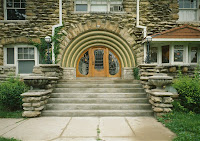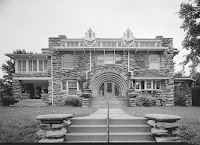History and Old Stuff...
 Image courtesy of Library of Congress, Prints and Photographs Division,
Image courtesy of Library of Congress, Prints and Photographs Division, Historic American Buildings Survey, HABS MO,48-KANCI,10-5
The curious arched doorway is the photo above is the main entry to Mineral Hall in Kansas City, MO.
Mineral Hall was built between 1903 and 1905. Its architect was Louis Curtiss (1865-1924). He was born in Ontario, Canada. After studying architecture in Toronto and Paris, he came to Kansas City around 1890, apparently attracted by the economic boom and extensive construction in the area.
According to Susan Jezak Ford, writing for the Kansas City Public Library, "[Curtiss] only wore white. He continually smoked monogrammed Turkish cigarettes. He was a reckless driver. Yet his legacy of buildings remains truly recognizable by their style and innovative designs."
The main part of the house was built by William Rule, who never lived in it. About a year after it was built, it was sold to Roland E. Bruner, a businessman with extensive personal and business interests in mining.
To house and showcase his extensive collection of minerals, Bruner employed Curtiss to design and add a wing to the house . The name Mineral Hall was given to the house because samples of local minerals were embedded in the mortar of the interior walls of Bruner's new wing.
The exterior of the home is Jackson County oolitic limestone -- that is, locally quarried stone. The door itself is an example of Art Noveau style. The total cost of the house, when built, was about $25,000.
Mineral Hall looks like the residence of a mining king. The doorway reminds me of a hobbit hole, but of course Louis Curtiss had no such influences on his imagination. In 1903, J. R. R. Tolkien was a mere lad of 11 years.
According to Ford, Louis Curtiss is buried in an unmarked grave in Kansas City's Mount Washington cemetery. He died in 1924, at work at his drafting table.
Mineral Hall is used today as the Admissions Office of the Kansas City Art Institute. The Art Institute website remarks that Mineral Hall's door is said to be "the most photographed doorway in Kansas City."
I found a description of Mineral Hall and the photos I've posted here in the Historic American Buildings Survey (HABS) at the Library of Congress website. Most of the details I've cited here come from the HABS documentation. If you want to read it yourself, the best way to find it is to visit the HABS homepage and type "Mineral Hall Kansas City" into the search bar.
Historic American Buildings Survey, HABS MO,48-KANCI,10-2
Note: I revised this a few hours after I posted it to organize it better and to include more information. I also separated some information into a second post about buildings designed by Louis Curtiss.
